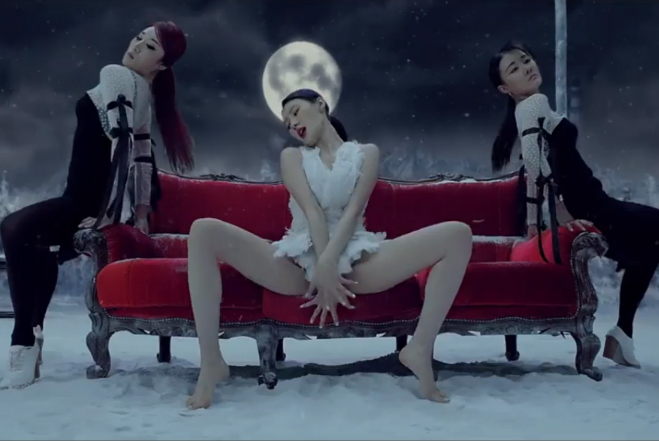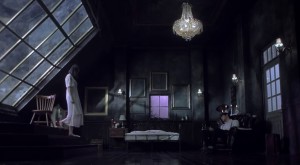 In the infinite gamut of K-pop concepts, the notion of maturity has often been represented by the ‘sexy’ concept the execution of which, unfortunately, does not deal with mental maturity. This concept, in recent times, has gained unparalleled popularity, unparalleled censure and unparalleled insight into the sexism which runs in the veins of male and female K-pop fans alike. However, the dichotomy between the “sexy oppa” and the “slutty unnie” has its shades of grey and it is from within this little concentrated mass of grey matter that the transgressive concept of the ‘Female Vampire’ emerges.
In the infinite gamut of K-pop concepts, the notion of maturity has often been represented by the ‘sexy’ concept the execution of which, unfortunately, does not deal with mental maturity. This concept, in recent times, has gained unparalleled popularity, unparalleled censure and unparalleled insight into the sexism which runs in the veins of male and female K-pop fans alike. However, the dichotomy between the “sexy oppa” and the “slutty unnie” has its shades of grey and it is from within this little concentrated mass of grey matter that the transgressive concept of the ‘Female Vampire’ emerges.
 When a skimpily attired and provocatively dancing ‘innocent’ and unaware girl, is replaced by a skimpily attired and provocatively dancing confident and sexually aware woman, transgression takes place. After all, what is more terrifying than a sexually aware woman walking out of the oppressive patriarchal shadow to satiate her sexual appetite, unshackled and undeterred? Baffled, the patriarchy tries to secure its hold on the sexually threatening woman in three ways: Incarceration wherein the woman is locked up to rot along with her decaying sexual appetite, often victim to domestic violence, Gaslighting or Ostracism wherein the sexual deviant is thrown out of ‘normal’ society.
When a skimpily attired and provocatively dancing ‘innocent’ and unaware girl, is replaced by a skimpily attired and provocatively dancing confident and sexually aware woman, transgression takes place. After all, what is more terrifying than a sexually aware woman walking out of the oppressive patriarchal shadow to satiate her sexual appetite, unshackled and undeterred? Baffled, the patriarchy tries to secure its hold on the sexually threatening woman in three ways: Incarceration wherein the woman is locked up to rot along with her decaying sexual appetite, often victim to domestic violence, Gaslighting or Ostracism wherein the sexual deviant is thrown out of ‘normal’ society.
This ostracized female sexual deviant haunting the fringes of society is known to mankind as the vampire, the woman with her monstrous desire for blood. But to think that such an aware woman will just sit quiet and submit to the distortion of her identity by the patriarchy is rather indigestible.
K-pop surprisingly understands this discrepancy and has mapped the growth of its powerful female vampires.
2WinS’ “Bleeding” deals with the creation of the female vampire rather splendidly. The MV opens with symbols of traditional purity from the generous dosage of white to its heteronormative ideology. Trouble brews when the line “Don’t get away from me, baby” echoes while Seulong adorns Shin Min-hee with a necklace having a cross for a pendant. The pendant then becomes symbolic of religion, the most powerful weapon of patriarchy, choking her fleshly desires, with the persuasive cajole of “Don’t get away” reeking of conditioning.
[youtube https://www.youtube.com/watch?v=eXjMmr0Ik0s]This is followed by a transition to the woman resembling a marble statue and Seulong putting makeup on her. The entire sequence is excitingly creepy because it is reminiscent of how the ‘sexy’ concept in K-pop is created. The woman is an object, dolled up for the male viewer, devoid of any subjectivity and sexually subservient to the man who owns her.
 When she awakens from her sleep of sexual inactivity, she transforms into a ‘new woman’ and this is best exemplified by her confident smirk and the breaking of the shackles around her ankles.
When she awakens from her sleep of sexual inactivity, she transforms into a ‘new woman’ and this is best exemplified by her confident smirk and the breaking of the shackles around her ankles.
But when a woman, who has internalized the patriarchal discourse for centuries, is given unlimited sexual power she feels helpless. It’s a new experience, a new identity, a sense of excessive freedom never undergone before. Shin Min-hee looks into the photo and finds herself caught between supplication and a venture into the wilderness. She chooses the latter as she lets go off her final bind (the necklace) and walks out. If ‘normal’ society fails to accommodate her she will create a society of her own.
With the lack of experiential knowledge, of guidance and more importantly, of companionship and support, the female vampire ventures on to find a place which will accommodate her and her newly found power and sexuality but the newness of it all leaves her perplexed. Her lack becomes a subject of mockery as she grabs onto condescending pillars of patriarchy to prove her worth, to prove she is as good as a man. Ivy’s “Touch Me” performance at the 2009 MAMA marks this period of awkward transition with her abundant sexuality and a sniggering male audience.
[youtube https://www.youtube.com/watch?v=tTZIlQ1iDbM]The performance opens with a visual clip showing a cloaked Ivy, the ‘cloak’ symbolizing the idea of a journey; of hiding and remnants of shame; seducing Chansung but she falls short of biting him. With the clip ending, we have an energetic Ivy dancing to the echoes of “Touch”. It is a complete reversal from docility and subservience. She is confident, assertive and very sexual but a cringing and mocking audience diminishes her newly acquired power into a mere sexual exhibition. Even when she leads Nickhun, he just looks amused, far from what he should feel in front of a formidable vampire.
 She is empowered because she does not shy away from demanding that he should “touch her now”, even her dance overtly demands sexual gratification but Nickhun’s amused smile renders her performance as another source of entertainment for the male gaze. But this performance marks a major level up in the growth of the female vampire: Ivy bites into Nickhun’s neck at the end and performs, symbolically, the act of penetration appropriating phallic power. The blood that flows out can easily be associated with the breaking of the hymen; the female vampire hence becomes the sexual agent.
She is empowered because she does not shy away from demanding that he should “touch her now”, even her dance overtly demands sexual gratification but Nickhun’s amused smile renders her performance as another source of entertainment for the male gaze. But this performance marks a major level up in the growth of the female vampire: Ivy bites into Nickhun’s neck at the end and performs, symbolically, the act of penetration appropriating phallic power. The blood that flows out can easily be associated with the breaking of the hymen; the female vampire hence becomes the sexual agent.
When her burning and irrepressible desire calms down, when she is more in control of her ‘new’ self; the female vampire sets about creating her world. In both 2WinS’ and Ivy’s performance, the female vampire is a shunned traveler but with 4Minute’s “Volume Up”, the female vampire creates a concrete space for herself albeit still isolated from ‘conventional’ society.
[youtube https://www.youtube.com/watch?v=qsWl1–Niyg]Hyuna walks into a sparsely furnished Gothic mansion as the MV begins, her gait exuding self assurance; she owns her body and is an autonomous agent. The sparse furnishings indicate the newness of the space. Hyuna may be its owner but she is still not familiar with the space neither has she completely personalized and internalized it but the choice of a Gothic mansion in itself reflects power, sexuality and mystery.
 As more members are introduced, it is evident that they are not out to seduce. They seem self sufficient in all aspects of life; whole and complete and the reason behind this self sufficiency is reflected in the presence of the active female dancers.
As more members are introduced, it is evident that they are not out to seduce. They seem self sufficient in all aspects of life; whole and complete and the reason behind this self sufficiency is reflected in the presence of the active female dancers.
The journey began with lone vampires but now a curious lesbian sisterhood of female vampires becomes visible. Whether it’s Hyuna standing unperturbed as various female hands feel her body or it’s their powerful choreography within close proximity, a tight bonding seems to hold these female vampires together. It is important to read the homosexual subtext because while the first stages of sexual freedom mark the awakening to something called sexuality, the later stage marks the awakening to sexual orientations; the heterosexual narrative is finally interrupted.
 This awakening is beautifully symbolized by Ga-yoon and the snake. The snake or serpent is symbolic of Satan in Paradise Lost. It is Satan in the form of a serpent who lures Eve to have the Forbidden Fruit. Ga-yoon represents an empowered and knowledgeable Eve, an Eve shunned by a patriarchal God for her overt sexual desires but an Eve who has grown powerful enough to have Satan as her pet.
This awakening is beautifully symbolized by Ga-yoon and the snake. The snake or serpent is symbolic of Satan in Paradise Lost. It is Satan in the form of a serpent who lures Eve to have the Forbidden Fruit. Ga-yoon represents an empowered and knowledgeable Eve, an Eve shunned by a patriarchal God for her overt sexual desires but an Eve who has grown powerful enough to have Satan as her pet.
The male vampires, interestingly, are only visible in their physical presence; they don’t seem to have any functional role. Token objects, they seem to be subservient to 4Minute, occasionally used as dancing partners or supporting pillars. None of the women seem to have any intention of pleasing them by submitting to their definition of femininity or masculinity. They have created their own and this creation manifests itself through the costumes. These female vampires have not equated acquisition of power to traditional male attire instead they take pride in their leather shorts, dresses and jewellery, the colour scheme gravitating towards black and red- power and sexuality. In many ways, this video comes closest to achieving a feminist utopia.
But a Utopia is utopian because of the simple fact that it is not achievable. Sunmi’s “Full Moon” realizes this and sets out to negotiate gender boundaries, this time taking the initiative to give men a chance at being members of a freer world.
[youtube https://www.youtube.com/watch?v=8BBF3vRY85M]The most prominent aspect of the MV apart from the female vampire herself is the moon. Gaya, in her review, calls it a “confidante” while I will take the liberty to say it is a reflection of Sunmi. The association of moon and women goes a long way back, farther than the times when the moon was just associated with a woman’s beauty. The moon transforms in cycles growing and dimming accordingly. These lunar cycles were associated with a woman’s menstrual cycles in several traditions. Since dominant narratives were male and since the concept of womb and of menstruation were so alien to the male psyche, they posited menstruating women as lunatics (from the word ‘lunar’). The stereotypes of moodiness, crankiness, irrationality and other behavioral fluctuations were further associated with menstruation. Isolated from human contact while menstruating, women were adorned with these stereotypes only to accentuate the biggest threat felt from them- heightened sexuality and fertility.
 Matching her cycles with the moon, the woman reaches the peak of her fertility during the full moon and when this woman is viewed as a female vampire, the peak equates to heightened supernatural powers. Sexuality equals power and in this heightened state Sunmi goes out to find her companion. The blending of her sexuality and power is best reflected by the choreography especially the one for the chorus alluding to the woman-on-top position.
Matching her cycles with the moon, the woman reaches the peak of her fertility during the full moon and when this woman is viewed as a female vampire, the peak equates to heightened supernatural powers. Sexuality equals power and in this heightened state Sunmi goes out to find her companion. The blending of her sexuality and power is best reflected by the choreography especially the one for the chorus alluding to the woman-on-top position.
The presence of Lena is interesting because she represents a younger generation of female vampires, most probably, taken care of by women (and men) who have achieved their place at the fringes after a long struggle. The fact that she is younger also indicates that sexual awakening does not take place at a particular age and more importantly, if you are sexually aware at a young age it is not a crime; it is natural and needs to be embraced. The more you try to suppress sexuality, the more chances of ugly repercussions.
 From the examples I have mentioned, Sunmi’s “Full Moon” is the only one where not only is she shown biting the man but we are also shown his transformation. While in Ivy’s case it was only phallic appropriation by this time it is something way more. The importance of this act is succinctly captured in Cyndy Hendershot’s essay Vampire and Replicant: The One-Sex Body in a Two-Sex World:
From the examples I have mentioned, Sunmi’s “Full Moon” is the only one where not only is she shown biting the man but we are also shown his transformation. While in Ivy’s case it was only phallic appropriation by this time it is something way more. The importance of this act is succinctly captured in Cyndy Hendershot’s essay Vampire and Replicant: The One-Sex Body in a Two-Sex World:
The act of a female vampire biting into a man’s chest/neck leads to “the confusion of fluids — blood for semen, blood for milk, a man’s blood for menstrual blood — of sexual acts — enforced fellatio on a man’s chest, a man breastfeeding a woman, a woman performing cunnilingus on a man’s chest — and of gender roles — a man nurturing a woman, a man’s chest substituting for a menstruating vagina.”
Very subtly, gender roles have been reversed and re-reversed, thrown into confusion. While there is no question of the fact that within the vampiric world there does exist socially gendered roles because no vampire lets go off his/her cultural and historical baggage but the biological gender or gendered sex is eliminated because the body refuses to identify with it. A vampire is not caught within the binaries of sex, it surpasses it.
Sunmi achieves what she and her sisterly precursors had set out to achieve: negotiate gender boundaries, but she does not extend her hand to the privileged males of the society instead she decides to help a physically, and by extension, socially disabled person. She chooses someone of her own kind to empower and preserves the vampiric space as the refuge for deviants.
But for all their supernatural prowess, they still shy from the scorching presence of the patriarchal sun fearful of ‘retribution’ for their transgression leaving us sighing dejectedly at the long distance of progress still left to cover.
(Johnson, Judith E. 1993. “Women Vampires: Nightmare or Utopia?”, The Kenyon Review, Hendershot, Cyndy. 1995. Vampire and Replicant: The One-Sex Body in a Two-Sex World, Kord, Susanne. “What is at Stake, Or Why We Cannot Let It (Them) Rest”, Murderesses in German Writing, 1720-1860: Heroines of Horror, Gilbert, Sandra M. and Gubar, Susan. “A Dialogue of Self and Soul: Plain Jane’s Progress”, The Madwoman in the Attic. YouTube [1] [2] [3] [4] Images via JYP Entertainment, Cube Entertainment, Mnet)


